| Happy Birthday : |

Trampoline - Olympic Sports
![]()
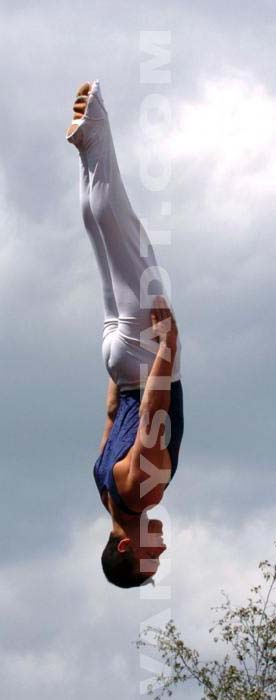
A competitor performs tricks in jumping and bouncing on a "trampoline".
The trampoline is both the name of a device used to bounce and the name of sport we practice it.
HistoryThe trampoline was born into the world of circus circus Hughes based in London, was used in a number. This is to him we owe the name "Trampoline".
In his book "Trampoline Tumbling" (published in 1942) American Larry Griswold wrote that the origin is due to 2 Italian trapeze artists calling themselves "Due Trampoline" and who have had the idea of using the elasticity of safety net to finish their exhibition by acrobatic leaps.
In 1926, George Nissen, a professor of Physical Education, taking the principle, develops a device, the forerunner of what we know, and whose full canvas was hung by rubber bands in a metal frame. The same year, his association with Griswold, will create the foundation for "gymnastics on the trampoline, making this name in honor of its origin. The tandem Griswold-Nissen then focuses on improving equipment, and design of this new sport.
During the 2nd World War, the trampoline was an instrument training for pilots of the U.S. military. The American and Soviet astronauts used it to test their body positions in the air. The first world championships were held in 1964 in London.
The International Federation Founded in England in 1965, ceased to exist in 1998. Since then, the trampoline is managed by the FIG. The French Federation of Sports in Trampoline Founded in 1965, was in turn dissolved in 1999. The trampoline, tumbling and acrobatics then integrate French Federation of Gymnastics.The trampoline made its Olympic debut in Sydney in 2000 with programs for men and women arousing the enthusiasm of all.
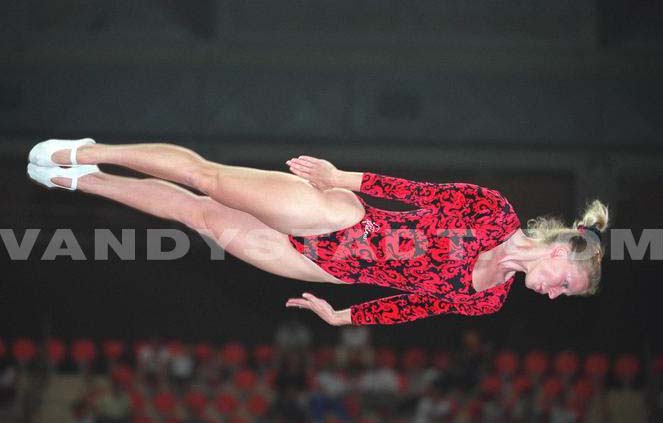
The trampoline is a
free web 10 consecutive jumps . At each hop, the aim is to multiplyersifier rotations of the body in space at a height greater than 7 meters. Internationally, men perform in approx 10 jumps. 23 rotations (21 for women) Type "salto" combined approx. 16 rotations of type "spin" (13 for women) by taking account of the recovery due to tight pike position and difficulty of approx. 14 points (12 points for women). During qualifying, each carries a trampoline imposed movement and free movement.
In general, during an official competition, a trampoline performs about 38 figures (15 and 23 rotations twisted saltos carp, grouped or tense). It takes 20 seconds to 10 jumps. The exercises must combine grace, precision and fluidity.
Competitions Team1. A trampoline team includes four women and four men.
2. Each team member must complete three years free.
3. The lowest score of the team is canceled after each pass (1st free, 2nd free, 3rd free).
Determination of winner1. The winner of a competition is the competitor with the best score at 3 or free the team with the highest total.
2. The same place is awarded to competitors who got the same note, in accordance with the regulations of continental championships and the world.
FacilitiesThe trampoline is a metal frame supporting the canvas on which the springs bouncing gymnast to perform exercises. The trampoline measures 5.05 m long, 2.91 m wide and 1.155 high. The canvas, thick only six millimeters, is made of nylon or rope.
During the tests simultaneously, trampolines should be arranged in parallel at a distance of two meters, and at the same level.
The clear head room must be at least eight meters. Trampolines realize their figures to 6 feet trampoline.
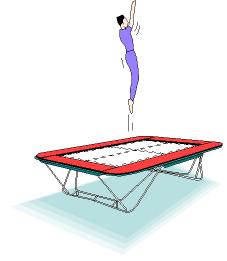
--
AcrobaticsIts origins go far back in history, not again do we not brought acrobatic Egyptian murals? But it is the countries of the East who have made a sport in itself, where the artistry was privileged.
CompetitionGymnastic activity on a platform of 12 m by 12 m, which allows to build a chain which figures are combined and collective elements in
iduels. These figures can be static or dynamic. The sequences presented by groups of composition and size are made of different porters, to throws, to dance and acrobatic elements performed on a musical theme.
Competitive groups: female Duo, Duo Joint Duo male female trio, male quartet.
- TumblingTumbling - common and male - from the English verb (to tumble) meaning "tumbling" from which the sequence of acrobatics.
Frescoes and engravings of acrobatics and dating from antiquity have been discovered in Egypt, Persia and Greece. They prove the existence of acrobats at the time.
In middle age, the acrobats were in the entertainment world and they
ertissaient nobles, like the "crazy" and "king of clowns" at the evening festivities.
The tumbling appears on two separate continents:
- North American championships in the United States 1886
- At the beginning of the twentieth century in Asia, where tumbling and gymnastics were not their first circus.
The tumbling is and will remain a sport "spectacle". It occurs particularly at the famous Cirque du Soleil.
Olympic sport in 1932 in Los Angeles, American Roland Wolfe became the first and only winner of this event reserved for male athletes.
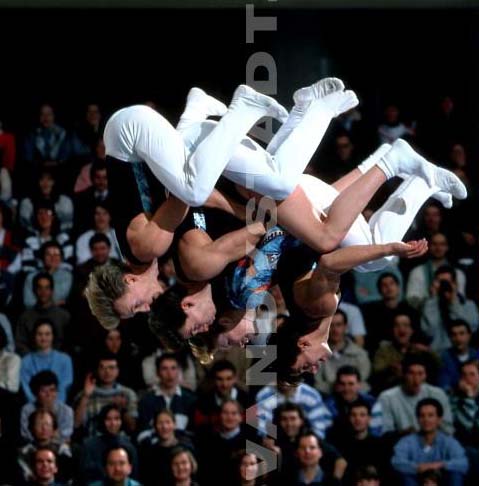
Despite the origin of the word 'tumbling', the masters of tumbling the Soviets and Chinese. We hear first from tumbling into the 30s, but it was not until the year 1965 to be the first ever World Championship (winners: Judy Wills Americans women and Frank Schmitz for men). The France that specialty practice successfully since 1980.
CompetitionThis very acrobatic sport that requires great force, is practiced on a track bouncing (for connoisseurs, bouncing over a gym floor). This track Freestyle 25m long and 1.50m wide, is accompanied by a runway of 11m and a reception (about 30 cm thick) for the final acrobatic tumblers. It consists of bars in fiberglass on which are placed 10 cm foam and carpeting. Tumbling is characterized by the sequence of fast-paced acrobatic elements (plop, saltos, tempos, spins, ...) made without breaking pace. Each series begins with picking up speed and ends on the receiving surface after the last part of that exercise should be conducted at a maximum height. Each "tumblers" to do three sets acrobatic somersaults, tendrils and combined.
GlossaryChandelle: vertical leap in pre-made series earlier this year to achieve the desired height before executing the first figure.
Salto: rotating vertical rows forward or back (flip)
Spin: longitudinal rotation.
Back: back somersault.
Ball / out: front somersault from the back.
Barani: front somersault with half twist
Cody back flip gone belly (as the forward is not used in competition)
Fliffis: double somersault with twist (s)
Triffi: twisting triple somersault (s)
Half: half twist
Full: 1 spin
Double full: 2 twists
Rudolph or Rudy: front somersault with a 1 / 2 spin
Randolph or Randy somersault with two 1 / 2 twists
Adolph or Ady: front somersault with three 1 / 2 twists
In: indicates that the figure referred to is made in the first somersault.
Out: indicates that the figure referred to is made in the last somersault.
All rotations forward include an odd number of 1 / 2 spin, while back rotations are an even number of 1 / 2 spin. Examples:
Barani out: double front somersault with 1 / 2 spin in the second.
Full in Barani out: double front somersault with 1 twist in the first and 1 / 2 spin in the second
Half in half out: double back somersault with 1 / 2 twist in each somersault
Half in Rudy out: double back somersault with 1 / 2 twist in the first and 1 spin 1 / 2 in the second.
Eouzan: double salto backward stretched legs shifted. Pascal Eouzan It is behind this jump.
Full full full: triple back somersault with a twist in each somersault. The full full full figure is currently the most complex work in international competition. They are Richard Tison and Lionel Pioline who are behind.
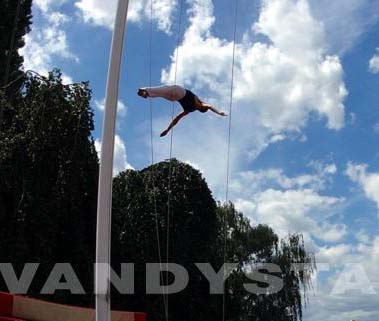
Copyright Sportquick/Promedi




_2018.jpg)
(9).jpg)
.jpg)

(7).jpg)






